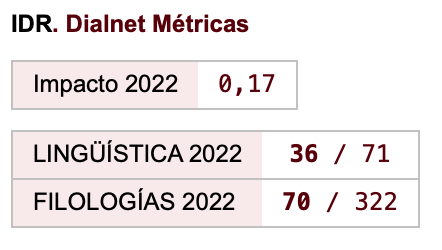(A)bridging the Gap – A study of the norms and laws in the intralingual translation of the novel And Then There Were None by Agatha Christie
Palabras clave:
intralingual, lectores por niveles, DTS, normas de traducción, leyes de traducción, Agatha Christie, And Then There Were NoneResumen
In the last decade, intralingual translation has started to gain momentum amongst a number of translation academics. Nevertheless, some types of intralingual translation remain largely undiscovered, such as the process of abridgement in the production of simplified versions of classic literary works (i.e. graded readers). This article subjects three chapters of the abridged version of And Then There Were None by Agatha Christie to qualitative analysis using Descriptive Translation Studies theory. The aim is to contribute to bridging a research gap in Translation Studies by examining the norms and laws governing the process of abridgement. Translation norms and laws are detected by situating the source and the target texts in their respective socio-cultural backgrounds and by analysing translation shifts. Relevant shifts are identified by means of a check-list of features elaborated on the basis of theory on graded readers, which classifies them into lexical, structural and information shifts. The results of the analysis showcase the vast research potential of intralingual translation for language learning purposes.
Keywords: Intralingual translation, abridgement, graded readers, DTS, translation norms, translation laws, Agatha Christie, And Then There Were None
Descargas
Citas
Albakry, M. (2004). ‘Linguistic and Cultural Issues in Literary Translation’. Translation Journal 8(3). <http://translationjournal.net/journal/29liter.htm>. [02/05/2019].
Baker, M. (2009). Introduction to the first edition. In Baker, M. (Ed.), Routledge Encyclopedia of Translation Studies (pp. 14-19). London: Routledge.
Bassett. J. (2011). A series editor’s view (1). In Day, R. et al. (Eds.), Bringing Extensive Reading into the Classroom (pp. 22-32). New York: Oxford University Press.
Ersland, A. (2014). IS CHANGE NECESSARY? A study of norms and translation universals in intralingual translation. Unpublished MA thesis. University of Bergen. <http://bora.uib.no/bitstream/handle/1956/7967/119571513.pdf;sequence=1>. [02/05/2019].
Fernández López, M. (2000). ‘Translation Studies in Contemporary Children’s Literature: A Comparison of Intercultural Ideological Factors’. Children’s literature Association Quarterly, 25(1), 29-37.
Hedge, T. (1985). Using Readers in Language Teaching. London: Macmillan.
Hill, D. R. (1992). Guide to Organising Programmes of Extensive Reading. <http://er-central.com/wp-content/uploads/EPER-Guide-1992.pdf>. [02/05/2019].
Jakobson, R. (2004). On Linguistic Aspects of Translation. In Venuti, L. (Ed.), The Translation Studies Reader (pp. 180-192). New York & London: Routledge.
Leow, R. P. (2007). ‘Review of Resources: Simplification and Second Language Acquisition’. World Englishes, 16(2), 291-296.
Munday, J. (2008). Introducing Translation Studies: theories and applications. 2nd edn. London: Routledge.
Pearson English Readers Catalogue (2019). <https://online.flippingbook.com/view/176977> [02/05/2019].
Schmid, B. (2008). A duck in rabbit's clothing: integrating intralingual translation. In Kaiser-Cooke, M. (Ed.), Das Entenprinzip: translation aus neuen Perspektiven (pp. 19-80). Bern: Peter Lang.
Simensen, A. M. (1987). ‘Adapted Readers: How are they Adapted?’. Reading in a Foreign Language 4(1), 41-57.
The Extensive Reading Foundation (2011). The Extensive Reading Foundation’s Guide to Extensive Reading. <http://erfoundation.org/guide/ERF_Guide.pdf> [02/05/2019].
Toury, G. (2012). Descriptive Translation Studies – and beyond. Revised edition. Amsterdam & Philadelphia: John Benjamins.
Oittinen, R. (2000). Translating for Children. New York: Garland.
Waring, R. (2003). Writing a Graded Reader. [02/05/2019].
Zethsen, K. K. (2007). ‘Beyond Translation Proper: Extending the field of translation studies’. TTR : Traduction, Terminologie, Rédaction 20(1), 281-308.
Zethsen, K. K. (2009). ‘Intralingual translation: An attempt at description’. Meta 54(4), 795-812.
Descargas
Publicado
Cómo citar
Número
Sección
Licencia
Aquellos autores/as que tengan publicaciones con esta revista, aceptan los términos siguientes:
- Los autores/as conservarán sus derechos de autor y garantizarán a la revista el derecho de primera publicación de su obra, el cuál estará simultáneamente sujeto a la Licencia de reconocimiento de Creative Commons que permite a terceros compartir la obra siempre que se indique su autor y su primera publicación esta revista.
- Los autores/as podrán adoptar otros acuerdos de licencia no exclusiva de distribución de la versión de la obra publicada (p. ej.: depositarla en un archivo telemático institucional o publicarla en un volumen monográfico) siempre que se indique la publicación inicial en esta revista.
- Se permite y recomienda a los autores/as difundir su obra a través de Internet (p. ej.: en archivos telemáticos institucionales o en su página web) antes y durante el proceso de envío, lo cual puede producir intercambios interesantes y aumentar las citas de la obra publicada. (Véase El efecto del acceso abierto).

Revista de Lenguas para fines específicos is licensed under a Creative Commons Reconocimiento-NoComercial-SinObraDerivada 4.0 Internacional License.
























